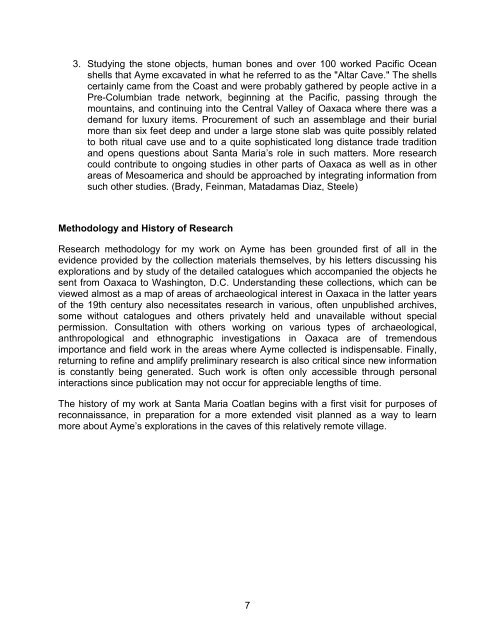Tracing Louis H. Ayme's Explorations in Oaxaca, México ... - Famsi
Tracing Louis H. Ayme's Explorations in Oaxaca, México ... - Famsi
Tracing Louis H. Ayme's Explorations in Oaxaca, México ... - Famsi
Create successful ePaper yourself
Turn your PDF publications into a flip-book with our unique Google optimized e-Paper software.
3. Study<strong>in</strong>g the stone objects, human bones and over 100 worked Pacific Ocean<br />
shells that Ayme excavated <strong>in</strong> what he referred to as the "Altar Cave." The shells<br />
certa<strong>in</strong>ly came from the Coast and were probably gathered by people active <strong>in</strong> a<br />
Pre-Columbian trade network, beg<strong>in</strong>n<strong>in</strong>g at the Pacific, pass<strong>in</strong>g through the<br />
mounta<strong>in</strong>s, and cont<strong>in</strong>u<strong>in</strong>g <strong>in</strong>to the Central Valley of <strong>Oaxaca</strong> where there was a<br />
demand for luxury items. Procurement of such an assemblage and their burial<br />
more than six feet deep and under a large stone slab was quite possibly related<br />
to both ritual cave use and to a quite sophisticated long distance trade tradition<br />
and opens questions about Santa Maria’s role <strong>in</strong> such matters. More research<br />
could contribute to ongo<strong>in</strong>g studies <strong>in</strong> other parts of <strong>Oaxaca</strong> as well as <strong>in</strong> other<br />
areas of Mesoamerica and should be approached by <strong>in</strong>tegrat<strong>in</strong>g <strong>in</strong>formation from<br />
such other studies. (Brady, Fe<strong>in</strong>man, Matadamas Diaz, Steele)<br />
Methodology and History of Research<br />
Research methodology for my work on Ayme has been grounded first of all <strong>in</strong> the<br />
evidence provided by the collection materials themselves, by his letters discuss<strong>in</strong>g his<br />
explorations and by study of the detailed catalogues which accompanied the objects he<br />
sent from <strong>Oaxaca</strong> to Wash<strong>in</strong>gton, D.C. Understand<strong>in</strong>g these collections, which can be<br />
viewed almost as a map of areas of archaeological <strong>in</strong>terest <strong>in</strong> <strong>Oaxaca</strong> <strong>in</strong> the latter years<br />
of the 19th century also necessitates research <strong>in</strong> various, often unpublished archives,<br />
some without catalogues and others privately held and unavailable without special<br />
permission. Consultation with others work<strong>in</strong>g on various types of archaeological,<br />
anthropological and ethnographic <strong>in</strong>vestigations <strong>in</strong> <strong>Oaxaca</strong> are of tremendous<br />
importance and field work <strong>in</strong> the areas where Ayme collected is <strong>in</strong>dispensable. F<strong>in</strong>ally,<br />
return<strong>in</strong>g to ref<strong>in</strong>e and amplify prelim<strong>in</strong>ary research is also critical s<strong>in</strong>ce new <strong>in</strong>formation<br />
is constantly be<strong>in</strong>g generated. Such work is often only accessible through personal<br />
<strong>in</strong>teractions s<strong>in</strong>ce publication may not occur for appreciable lengths of time.<br />
The history of my work at Santa Maria Coatlan beg<strong>in</strong>s with a first visit for purposes of<br />
reconnaissance, <strong>in</strong> preparation for a more extended visit planned as a way to learn<br />
more about Ayme’s explorations <strong>in</strong> the caves of this relatively remote village.<br />
7
















